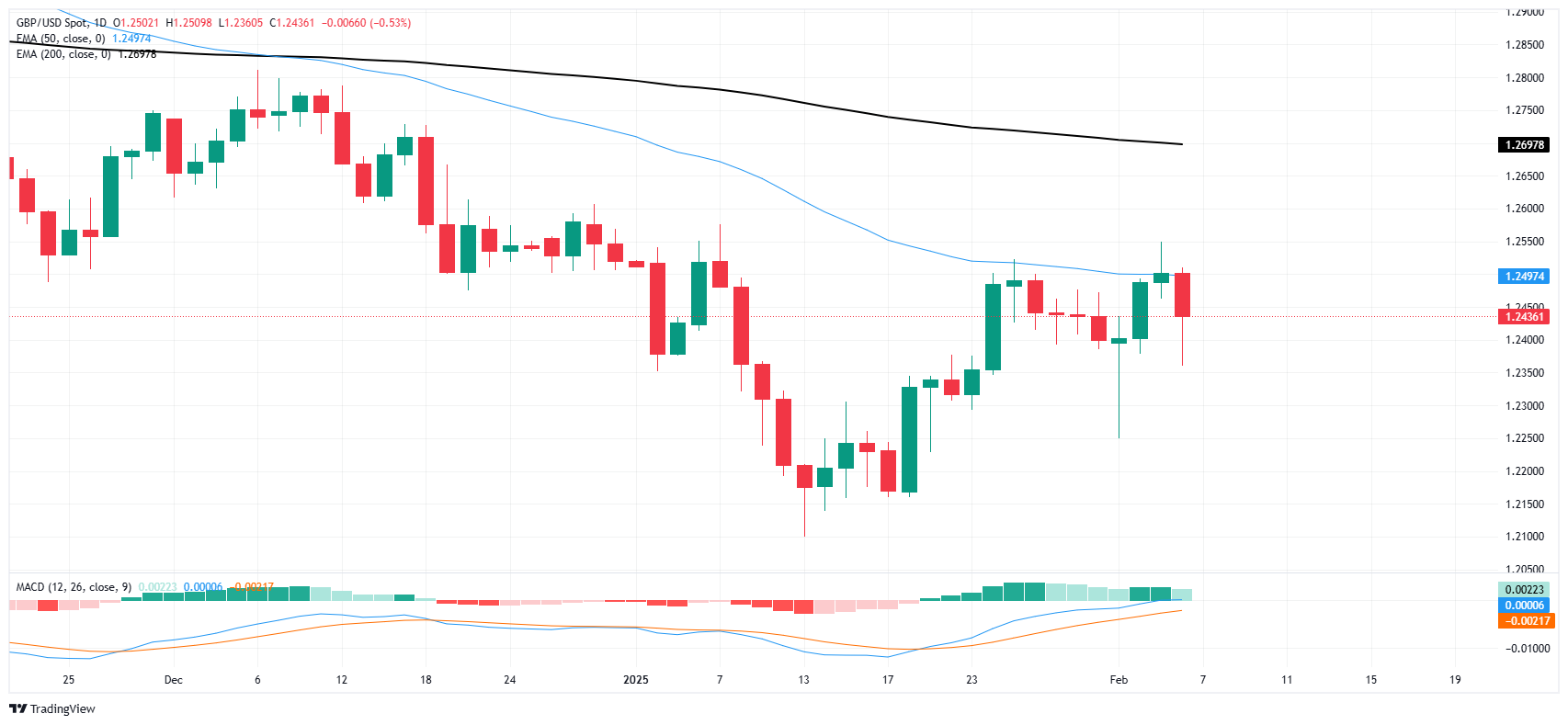GBP/USD pulls back after BoE rate cut
- GBP/USD briefly tumbled back below 1.2400 after the BoE cut rates again.
- Despite the rate cut, BoE tones struck a hawkish chord, crimping further bets.
- US NFP Friday looms large ahead to cap off the trading week.
GBP/USD shuddered on Thursday, punching in a technical rejection from key averages and testing below the 1.2400 handle. The Bank of England (BoE) trimmed interest rates by another 25 bps, but struck a hawkish tone that saw rate markets tune down their bets of further rate cuts through the remainder of 2025.
According to rate markets, the BoE will likely make another two or three rate cuts through the year. All nine members of the Monetary Policy Committee (MPC) voted for a rate cut, with seven voting for a 25 bps rate trim and two particularly-dovish members voting for a double-cut for 50 bps. Despite the accelerated eagerness of policymakers to deliver a February rate cut, markets only expect another 70 or so basis points to be taken off the BoE’s reference rate this year.
Another Nonfarm Payrolls (NFP) jobs data dump looms on Friday. Net job additions are expected to ease to 170K in January, down from December’s print of 256K. Revisions to older data will be closely watched this week. Post-print revisions drifted toward the stronger side during 2024, frustrating market participants hoping for cracks in the US employment landscape to help push the Federal Reserve (Fed) toward more rate cuts.
GBP/USD price forecast
Thursday’s bearish pullback saw GBP/USD price in a technical rejection of the 50-day Exponential Moving Average (EMA), touching an intraday low near 1.2350. The pair settled the day a little south of 1.2450, but further bearish momentum could be on the cards as bulls struggle to sustain momentum.
GBP/USD daily chart
Pound Sterling FAQs
The Pound Sterling (GBP) is the oldest currency in the world (886 AD) and the official currency of the United Kingdom. It is the fourth most traded unit for foreign exchange (FX) in the world, accounting for 12% of all transactions, averaging $630 billion a day, according to 2022 data. Its key trading pairs are GBP/USD, also known as ‘Cable’, which accounts for 11% of FX, GBP/JPY, or the ‘Dragon’ as it is known by traders (3%), and EUR/GBP (2%). The Pound Sterling is issued by the Bank of England (BoE).
The single most important factor influencing the value of the Pound Sterling is monetary policy decided by the Bank of England. The BoE bases its decisions on whether it has achieved its primary goal of “price stability” – a steady inflation rate of around 2%. Its primary tool for achieving this is the adjustment of interest rates. When inflation is too high, the BoE will try to rein it in by raising interest rates, making it more expensive for people and businesses to access credit. This is generally positive for GBP, as higher interest rates make the UK a more attractive place for global investors to park their money. When inflation falls too low it is a sign economic growth is slowing. In this scenario, the BoE will consider lowering interest rates to cheapen credit so businesses will borrow more to invest in growth-generating projects.
Data releases gauge the health of the economy and can impact the value of the Pound Sterling. Indicators such as GDP, Manufacturing and Services PMIs, and employment can all influence the direction of the GBP. A strong economy is good for Sterling. Not only does it attract more foreign investment but it may encourage the BoE to put up interest rates, which will directly strengthen GBP. Otherwise, if economic data is weak, the Pound Sterling is likely to fall.
Another significant data release for the Pound Sterling is the Trade Balance. This indicator measures the difference between what a country earns from its exports and what it spends on imports over a given period. If a country produces highly sought-after exports, its currency will benefit purely from the extra demand created from foreign buyers seeking to purchase these goods. Therefore, a positive net Trade Balance strengthens a currency and vice versa for a negative balance.

